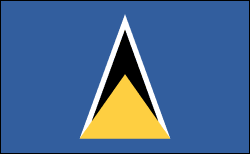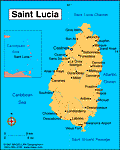St. Lucia | Facts & Information

- St. Lucia Profile
Facts & Figures
-
Sovereign: Queen Elizabeth II (1952)
Governor-General: Dame Pearlette Louisy (1997)
Prime Minister: Kenny Anthony (2011)
Land area: 236 sq mi (611 sq km); total area: 238 mi (616 sq km)
Population (2014 est.): 163,362 (growth rate: 0.35%); birth rate: 13.94/1000; infant mortality rate: 11.75/1000; life expectancy: 77.41; density per sq mi: 672
Capital and largest city (2011 est.): Castries, 21,000
Monetary unit: East Caribbean dollar
Languages: English (official), French patois
Ethnicity/race: black 85.3%, mixed 10.9%, East Indian 2.2%, other or unspecified 1.7% (2010 est.)
Religions: Roman Catholic 61.5%, Seventh-Day Adventist 10.4%, Pentecostal 8.9%, Evangelical 2.3%, Anglican 1.6%, other Christian 3.4%, Rastafarian 1.9%, none 5.9% (2010 est.)
Literacy rate: 90.1% (2001 est.)
Economic summary: GDP/PPP (2013 est.): $2.216 billion; per capita $13,100. Real growth rate: 0.2%. Inflation: 5.3%. Unemployment: 20% (2003 est.). Arable land: 4.84% (2011 est.). Agriculture: bananas, coconuts, vegetables, citrus, root crops, cocoa. Labor force: 79,700 (2012 est.); agriculture 21.7%, industry, commerce, and manufacturing 24.7%, services 53.6% (2002 est.). Industries: tourism; clothing, assembly of electronic components, beverages, corrugated cardboard boxes, lime processing, coconut processing. Natural resources: forests, sandy beaches, minerals (pumice), mineral springs, geothermal potential. Exports: $206.8 million (2013 est.): bananas 41%, clothing, cocoa, avocados, mangoes, coconut oil. Imports: $592.7 million (2013 est.): food 23%, manufactured goods 21%, machinery and transportation equipment 19%, chemicals, fuels. Major trading partners: UK, U.S., Brazil, Peru, France, Grenada, Barbados, Antigua and Barbuda, Dominica, Trinidad and Tobago (2012).
Member of Commonwealth of Nations
Communications: Telephones: main lines in use: 36,800 (2012); mobile cellular: 227,000 (2012). Radio broadcast stations: AM 2, FM 7 (plus 3 repeaters), shortwave 0 (2003). Radios: 111,000 (1997). Television broadcast stations: 3 (2 commercial broadcast stations and 1 community antenna television or CATV channel) (2007). Televisions: 32,000 (1997). Internet Service Providers (ISPs): 100 (2012). Internet users: 142,900 (2009).
Transportation: Railways: 0 km. Highways: total: 1,210 km (2011 est.). Ports and harbors: Castries, Cul-de-Sac, Vieux-Fort. Airports: 2 (2013).
International disputes: joins other Caribbean states to counter Venezuela's claim that Aves Island sustains human habitation, a criterion under United Nations Convention on the Law of the Sea, which permits Venezuela to extend its Economic Exclusion Zone/continental shelf over a large portion of the eastern Caribbean Sea.









